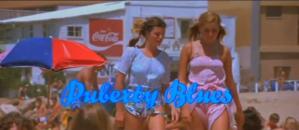 5392224246055011330.jpg
5392224246055011330.jpg
 5392224246055011330.jpg
5392224246055011330.jpg
| Text | Unit Name | Institution | Year |
|---|---|---|---|
form
y
 Puberty Blues
( dir. Bruce Beresford
)
Sydney
:
Limelight Productions
,
1981
Z826184
1981
single work
film/TV
(taught in 3 units)
Puberty Blues
( dir. Bruce Beresford
)
Sydney
:
Limelight Productions
,
1981
Z826184
1981
single work
film/TV
(taught in 3 units)
Debbie and Sue are accepted into Greenhill Beach's gang, an elite group of teenagers occupying a particular stretch of Cronulla beachfront. As surfie groupies, Debbie and Sue find out that they are expected to submit to male whims and play out 'strange' rituals, such as not eating or going to the bathroom when a boy is around. The girls' life mainly consists of doing what everyone else does: watching the boys surf, having sex with them (in the back seat of cars and at home-alone parties), and getting drunk. The narrative maintains a humorously ironic distance from the awfulness of the scene, particularly through the use of narration. The boys, though portrayed as collectively dominant, are individually consigned to the margins, while Debbie and Sue ultimately break out of the confines of male-imposed rules. |
Australian Film and Literature | University of South Australia | 2011 (Semester 2) |
form
y
 Puberty Blues
( dir. Bruce Beresford
)
Sydney
:
Limelight Productions
,
1981
Z826184
1981
single work
film/TV
(taught in 3 units)
Puberty Blues
( dir. Bruce Beresford
)
Sydney
:
Limelight Productions
,
1981
Z826184
1981
single work
film/TV
(taught in 3 units)
Debbie and Sue are accepted into Greenhill Beach's gang, an elite group of teenagers occupying a particular stretch of Cronulla beachfront. As surfie groupies, Debbie and Sue find out that they are expected to submit to male whims and play out 'strange' rituals, such as not eating or going to the bathroom when a boy is around. The girls' life mainly consists of doing what everyone else does: watching the boys surf, having sex with them (in the back seat of cars and at home-alone parties), and getting drunk. The narrative maintains a humorously ironic distance from the awfulness of the scene, particularly through the use of narration. The boys, though portrayed as collectively dominant, are individually consigned to the margins, while Debbie and Sue ultimately break out of the confines of male-imposed rules. |
Australia Imagined: Identity and Diversity in Australian Film and Literature | University of South Australia | 2012 (Semester 2) |
form
y
 Puberty Blues
( dir. Bruce Beresford
)
Sydney
:
Limelight Productions
,
1981
Z826184
1981
single work
film/TV
(taught in 3 units)
Puberty Blues
( dir. Bruce Beresford
)
Sydney
:
Limelight Productions
,
1981
Z826184
1981
single work
film/TV
(taught in 3 units)
Debbie and Sue are accepted into Greenhill Beach's gang, an elite group of teenagers occupying a particular stretch of Cronulla beachfront. As surfie groupies, Debbie and Sue find out that they are expected to submit to male whims and play out 'strange' rituals, such as not eating or going to the bathroom when a boy is around. The girls' life mainly consists of doing what everyone else does: watching the boys surf, having sex with them (in the back seat of cars and at home-alone parties), and getting drunk. The narrative maintains a humorously ironic distance from the awfulness of the scene, particularly through the use of narration. The boys, though portrayed as collectively dominant, are individually consigned to the margins, while Debbie and Sue ultimately break out of the confines of male-imposed rules. |
Australian Texts And Traditions | University of Tasmania | 2010 (Semester 2) |